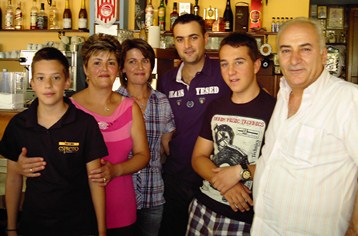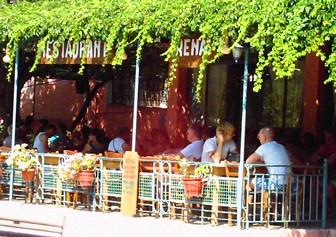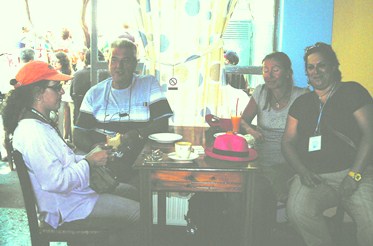 |
|
|
Traveling to Lesvos? Dine at Rena's Restaurant in Vatoussa by Mary Papoutsy [Maria Papoutzis] |
|
| For about 10 years we've been traveling to the Aegean island Lesvos, usually in summer months, but also occasionally during the spring and fall. One of the largest islands in this sea, its diversity of natural habitats and warm, hospitable populace make it a relatively "undiscovered" gem among travel destinations. Unlike more touristy locales like Mykonos and Santorini, vacationing in charming Lesvos has remained affordable. Of the tourists who usually visit, many are Greeks from the mainland. They arrive with their children during the traditional August holiday and head for oceanside towns and beaches. Another group that frequently swells the summertime population are those retired Mytilineans who reside in Athens and head for their tiny family homes in picaresque villages. Periodically we observe German tourists near the beaches or British birdwatchers in the springtime. Occasinonally we run into Russian and Polish tourists ferried about by bus. But for the most part, the island still has the feel of a sleepy town. There is much to see here. Every year we revisit favorite spots and venture out to explore new points of interest. There are monasteries, museums, thermal spas, workshops of legendary artisans, and much more. The island boasts ruins from every major period in recorded Greek history and even a pre-historic petrified forest. Locals tell us that the village where we lodge was once the center of a volcanic caldera, explaining the island's well-preserved petrified forest. A global treasure, the petrified forest is now a natural park with designated walkways, attractive vistas, and a nice museum. A short distance from this natural wonder is the seaside town of Sigri, with nice eateries and breathtaking views on the winding drive down the mountains toward the shore. Balmy sea breezes welcome visitors, encouraging afternoon sojourns and trips to its nice beaches. There are remains of a medieval castle, too. And a short distance before Sigri there is the Ypsilou Monastery perched atop a mountainside, offering a fine glimpse into Byzantine Orthodoxy, reachable by paved roadway. |
|
| On your drive back to the central or eastern portions of the island, be sure to stop at Rena's Restaurant in Vatoussa. It's conveniently located along the main road with plenty of parking just across the street in the town's public lot. We've dined frequently at Rena's. The reason, of course, is simple: Rena's has the best home-style cooking on the island. (It helps, too, that Rena's is situated just down the street from our lodging and that we've become acquainted with the family that owns and runs the establishment.) Tryphon, the owner, runs the eatery with his wife, sons, and nephews. Named after the owner's wife, Mrs. Rena Kalogerellis, the restaurant-coffee house is patronized not only by locals, but also by tour buses. Their menu features several daily specials and a list of traditional dishes. (See Matt Barrett's travel blog about Rena's and the owner's facebook page for the restaurant at http://www.greecetravel.com/matt-blog/2010-7-21.htm and http://www.facebook.com/pages/CAFE-RESTAURANT-RENA/214675665226140?sk=wall) |
 Kalogerellis Family |
One of my favorites is their baked pastitsio; my husband loves the meatballs and Greek-style beans. The "crema" topping for the pastitsio, a type of bechamel sauce, is thick, yet light and delicious. Most commercial preparation of this dish, which we sometimes describe for our American friends as Greek-style lasagna, falls far short with the crema. But Rena's is wonderful, arguably the best I've ever sampled. Underneath her crema are the traditional layers of elbow macaroni and ground beef infused with a light cheese-flavored cream sauce. Tryphon's small meatballs are traditional-style, prepared with a mixture of bread crumbs, finely chopped onions,and ground meat. Undoubtedly he adds spices, following a recipe handed down in his family. The rounded mixtures are then dusted with flour and rapidly and briefly cooked in olive oil until browned. Mm-mm good! |
|
| Tryphon does all the grilling, while Rena prepares the oven-cooked dishes. Tender and tasty stuffed tomatoes and peppers, stuffed squash blossoms, fava beans, meat stews, fried potato balls, moussaka, grape leaves, spicy meatballs (soutzoukakia), as well as the traditional salads, fill Rena's menu. Greek salads, known within Greece as "horiatika" [country-style] salads, are superb here, using home-grown vegetables. Sweet, ripe tomatoes, creamy local feta cheese, firm, crisp cucumbers, and wrinkled local black olives make up a "horiatiki salata." And if patrons have a yen for grilled meat, Tryphon offers fresh, sizzling cuts--usually lamb, veal, or chicken. We have found prices reasonable in comparison to what we would spend in the U.S., and consistent with other restaurants on the island. Without wine--which is often one of the excellent local wines produced from grapes grown in the area's rich, volcanic earth--a pair of meals might cost the equivalent of U.S.$12-20. |
 Rena's Restaurant & Cafe, Vatoussa, Lesvos |
Locals tend to sit and while away the morning and early afternoon at the restaurant-kafeneion, drinking coffee or ouzo, many of them farmers or shepherds who have risen before dawn to tend to their plots or livestock. We hear them going about their work as the sun rises, with donkeys braying or sheep's bells gently tinkling. It's a very tranquil, serene pattern of activity belonging to rural villages. We, too, complete our morning work, writing and editing, before we make a beeline to Rena's for the best breakfast anywhere. Thoughts of fresh eggs, local honey and Greek yogurt, bread baked in the village bakeries, locally grown fruit--often honeydew melon--and real ham and bacon make our mouths water as we walk down the cobblestone streets of Vatoussa village to the lower square. Rena and Tryfon use local, organic produce whenever possible, a fact that we can confirm: we've observed regular deliveries from local farmers and relatives who bring vegetables, fruit, eggs, yogurt, honey, meats and bread. Their breakfasts have become the standard for our morning meals across the globe, and no one has yet matched their freshness and flavor. |
|
| If we linger long enough, we can watch the Kalogerellis family cook and serve for a tour bus that stops late in the morning a couple times each week. With smooth efficiency, the entire family--sons and nephews, too--appears instantly to begin taking orders and setting tables. In no time at all, food and beverages appear on the tables, and the travelers are eating a light meal or snack. A couple of times we struck up conversation with one of the tour guides, Irene Nerantzi, (irenanzi@yahoo.gr) a gregarious lady whose multilingual expertise has kept her busy in the travel industry. She concurred with our assessment of Rena's and added that the place was always spotless, another reason for stopping at Vatoussa with visitors. (For more information about the village Vatoussa and surrounding area, visit the URL's http://www.lesvos.com/vatousa/index.html and Matt Barrett's Lesvos travel blog at http://www.lesvos.com/ .) |
 Tour Guide Irene Nerantzi (right), with island visitors |
|
|
|
|
(Posting date 12 July 2012) Article and photos by Mary Papoutsy. All rights reserved. HCS encourages readers to view other articles and releases in our permanent, extensive archives at the URL http://www.helleniccomserve.com/contents.html. |
|
|
|
|
2000 © Hellenic Communication Service, L.L.C. All Rights Reserved.
http://www.HellenicComServe.com |
|
